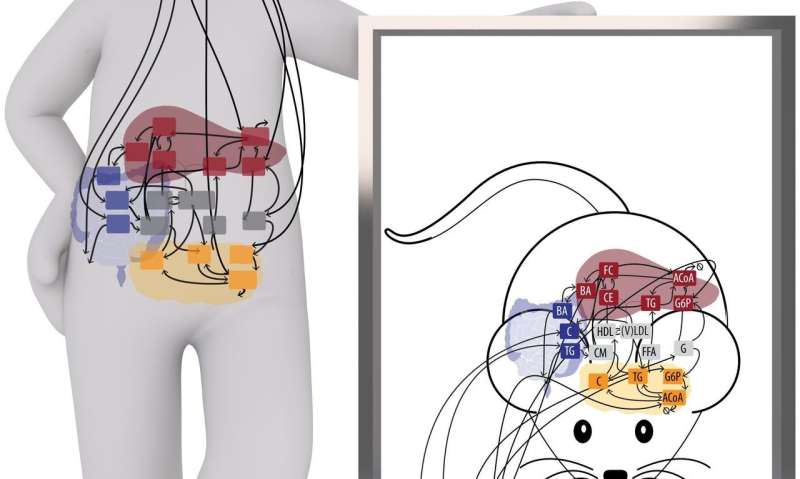The study published by Rozendaal et al. makes use of a genetically modified animal model of which its metabolic system resembles that of the human. They have created a computational model that describes the major pathways in carbohydrate, fat and cholesterol metabolism. This model is graphically depicted in the block diagram that is displayed on top of the mouse. The arrows indicate transfer and exchange of different metabolites (denoted by the abbreviations in the boxes) between different tissues. Note that this model is also valid for the human metabolic system as well. Credit: Rozendaal et al.
Scientists have developed a new computational model that accurately predicts the gradual, long-term progression of metabolic syndrome in mice. The model, created by Yvonne Rozendaal of Eindhoven University of Technology in the Netherlands and colleagues, is presented in PLOS Computational Biology.
Metabolic syndrome is a collection of several factors: obesity, insulin resistance, elevated lipid levels in the blood, and high blood pressure. A person with metabolic syndrome faces increased risk of cardiovascular disease, type 2 diabetes, and non-alcoholic fatty liver disease. Computational modeling of metabolic syndrome can provide new insights into its development, but previous modeling efforts have not fully captured the gradual progression and complexity of the disease.
In the new study, Rozendaal and colleagues developed a new computational model that describes glucose, lipid, and cholesterol metabolism—central factors in metabolic syndrome. A previously developed simulation method was applied to the model, allowing for accurate prediction of gradual, long-term development of the disease. The scientists then ran the model using data from real-world experiments in which mice were fed diets that resulted in development of metabolic syndrome.
The researchers found that their modeling approach correctly predicted progression of metabolic syndrome in the mice, as well as development of comorbidities, such as fatty liver disease. The model also uncovered the unexpected existence of two disease subtypes in the mice: those with elevated lipid levels and those without. It correctly predicted underlying metabolic differences that could explain the two subtypes, which were confirmed with experimental data.
"Our model is an important step in understanding the development of metabolic syndrome, offering new opportunities to identify strategies to prevent the disease and its comorbidities," Rozendaal says. "Our framework can also be applied to study long-term development of other complex, progressive diseases."
More information: Rozendaal YJW, Wang Y, Paalvast Y, Tambyrajah LL, Li Z, Willems van Dijk K, et al. (2018) In vivo and in silico dynamics of the development of Metabolic Syndrome. PLoS Comput Biol 14(6): e1006145. doi.org/10.1371/journal.pcbi.1006145
Journal information: PLoS Computational Biology
Provided by Public Library of Science
























